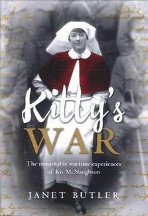Kitty's war by Janet Butler

Queensland University Press, 2013. ISBN: 9780702249679.
Recommended. Biography. Memoirs. This book tells the story of Kit
McNaughton, a nurse in World War I. It describes the conditions that
nurses lived under in the pre-war years, the restrictions that
female nurses endured and their position in society. Kit was a
'country girl' and the freedom and excitement of being on a troop
ship, dining with the officers and enjoying the privilege that only
rich people could usually afford, was heady indeed. Then came
the arrival in Egypt, the experience of a change in culture and the
life of the Egyptian people. Nurses were volunteers and didn't
accept the British discipline very well. At this stage of the story
there is more mention of visiting the Pyramids and Sphinx than the
care and nursing of the wounded. Perhaps she didn't want to dwell on
this as she was still in a state of excitement of being overseas.
Later she does describe the poor facilities, the hardships the
wounded endured and the delay in getting them medical attention as
they arrived in huge numbers.
On Lemnos Island, the hospital consisted of tents. The weather was
freezing and the island was wind swept, causing the tents to
collapse. This was bad for the nurses, but much worse for the
wounded. The nurses didn't complain about the bad conditions -
limited food, clothes and accommodation - as they believed they had
to handle them, as did the troops. In addition to the abysmal
conditions, the men were also wounded. This side of the war was not
mentioned in the diaries of the nurses. As the nurses did not
hold the rank of an officer, a difficult situation emerged where the
nurses were unable to give instructions to male orderlies working
with them - despite the fact they had three years nursing experience
and the orderlies had only three months.
I have read much about the action on the front lines and the
trenches but this story has been a real eye-opener.
Kit goes by troop ship to Marseilles and on shore there was little
to do until the nurses went to a hospital to look after wounded
German prisoners. She is eventually sent north to an English
hospital where things were difficult - as the British nurses were
attached to the Military - unlike our Australian volunteers.
She is later stationed at an Australian Casualty clearing station,
where the conditions are appalling. At this point, she is writing
less of what she is doing in her diary. A lot of friends she has
made along the way are being wounded or killed. The war is taking
its toll on her health and the diary rarely mentions her nursing
duties.
We eventually read of her trip back to Australia, her arrival in
Melbourne and the subsequent parade. Her health is failing and she
is on leave until she recovers. She then works in the Caulfield
Military Hospital for a time, before going home to Werribee and
marrying a farmer.
I was especially interested at this point, as my maternal
Grandmother nursed the soldiers at this same hospital after the war.
I highly recommend this book to students of Australian war history,
of the history of Nursing, and to anyone who is interested in
Australians at war.
Bob Quinton